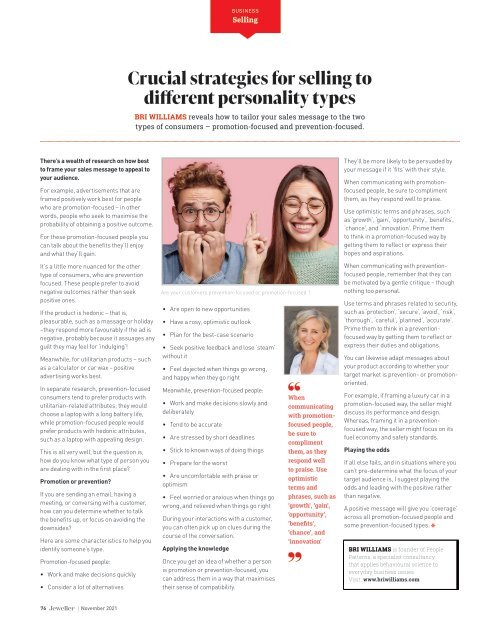Create successful ePaper yourself
Turn your PDF publications into a flip-book with our unique Google optimized e-Paper software.
BUSINESS<br />
Selling<br />
Crucial strategies for selling to<br />
different personality types<br />
BRI WILLIAMS reveals how to tailor your sales message to the two<br />
types of consumers – promotion-focused and prevention-focused.<br />
There’s a wealth of research on how best<br />
to frame your sales message to appeal to<br />
your audience.<br />
For example, advertisements that are<br />
framed positively work best for people<br />
who are promotion-focused – in other<br />
words, people who seek to maximise the<br />
probability of obtaining a positive outcome.<br />
For these promotion-focused people you<br />
can talk about the benefits they’ll enjoy<br />
and what they’ll gain.<br />
It’s a little more nuanced for the other<br />
type of consumers, who are prevention<br />
focused. These people prefer to avoid<br />
negative outcomes rather than seek<br />
positive ones.<br />
If the product is hedonic – that is,<br />
pleasurable, such as a massage or holiday<br />
–they respond more favourably if the ad is<br />
negative, probably because it assuages any<br />
guilt they may feel for ‘indulging’!<br />
Meanwhile, for utilitarian products – such<br />
as a calculator or car wax – positive<br />
advertising works best.<br />
In separate research, prevention-focused<br />
consumers tend to prefer products with<br />
utilitarian-related attributes; they would<br />
choose a laptop with a long battery life,<br />
while promotion-focused people would<br />
prefer products with hedonic attributes,<br />
such as a laptop with appealing design.<br />
This is all very well, but the question is,<br />
how do you know what type of person you<br />
are dealing with in the first place?<br />
Promotion or prevention?<br />
If you are sending an email, having a<br />
meeting, or conversing with a customer,<br />
how can you determine whether to talk<br />
the benefits up, or focus on avoiding the<br />
downsides?<br />
Here are some characteristics to help you<br />
identify someone’s type.<br />
Promotion-focused people:<br />
• Work and make decisions quickly<br />
• Consider a lot of alternatives<br />
Are your customers prevention-focused or promotion-focused ?<br />
• Are open to new opportunities<br />
• Have a rosy, optimistic outlook<br />
• Plan for the best-case scenario<br />
• Seek positive feedback and lose ‘steam’<br />
without it<br />
• Feel dejected when things go wrong,<br />
and happy when they go right<br />
Meanwhile, prevention-focused people:<br />
• Work and make decisions slowly and<br />
deliberately<br />
• Tend to be accurate<br />
• Are stressed by short deadlines<br />
• Stick to known ways of doing things<br />
• Prepare for the worst<br />
• Are uncomfortable with praise or<br />
optimism<br />
• Feel worried or anxious when things go<br />
wrong, and relieved when things go right<br />
During your interactions with a customer,<br />
you can often pick up on clues during the<br />
course of the conversation.<br />
Applying the knowledge<br />
Once you get an idea of whether a person<br />
is promotion or prevention-focused, you<br />
can address them in a way that maximises<br />
their sense of compatibility.<br />
When<br />
communicating<br />
with promotionfocused<br />
people,<br />
be sure to<br />
compliment<br />
them, as they<br />
respond well<br />
to praise. Use<br />
optimistic<br />
terms and<br />
phrases, such as<br />
‘growth’, ‘gain’,<br />
‘opportunity’,<br />
‘benefits’,<br />
‘chance’, and<br />
‘innovation’<br />
They’ll be more likely to be persuaded by<br />
your message if it ‘fits’ with their style.<br />
When communicating with promotionfocused<br />
people, be sure to compliment<br />
them, as they respond well to praise.<br />
Use optimistic terms and phrases, such<br />
as ‘growth’, ‘gain’, ‘opportunity’, ‘benefits’,<br />
‘chance’, and ‘innovation’. Prime them<br />
to think in a promotion-focused way by<br />
getting them to reflect or express their<br />
hopes and aspirations.<br />
When communicating with preventionfocused<br />
people, remember that they can<br />
be motivated by a gentle critique – though<br />
nothing too personal.<br />
Use terms and phrases related to security,<br />
such as ‘protection’, ‘secure’, ‘avoid’, ‘risk’,<br />
‘thorough’, ‘careful’, ‘planned’, ‘accurate’.<br />
Prime them to think in a preventionfocused<br />
way by getting them to reflect or<br />
express their duties and obligations.<br />
You can likewise adapt messages about<br />
your product according to whether your<br />
target market is prevention- or promotionoriented.<br />
For example, if framing a luxury car in a<br />
promotion-focused way, the seller might<br />
discuss its performance and design.<br />
Whereas, framing it in a preventionfocused<br />
way, the seller might focus on its<br />
fuel economy and safety standards.<br />
Playing the odds<br />
If all else fails, and in situations where you<br />
can’t pre-determine what the focus of your<br />
target audience is, I suggest playing the<br />
odds and leading with the positive rather<br />
than negative.<br />
A positive message will give you ‘coverage’<br />
across all promotion-focused people and<br />
some prevention-focused types.<br />
BRI WILLIAMS is founder of People<br />
Patterns, a specialist consultancy<br />
that applies behavioural science to<br />
everyday business issues.<br />
Visit: www.briwilliams.com<br />
76 | <strong>November</strong> <strong>2021</strong>


















